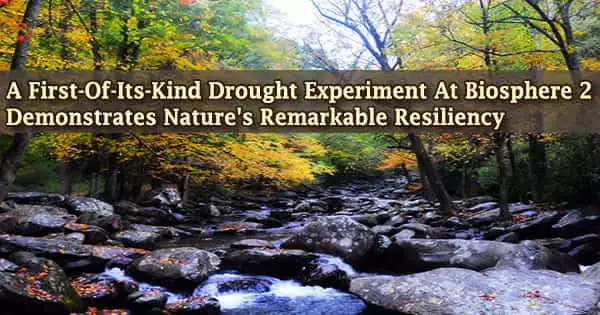To gain a better understanding of how global climate change will affect Earth’s ecosystems, an international team of 80 researchers embarked on an unprecedented experiment: forcing the world’s only enclosed rainforest, housed in the University of Arizona’s Biosphere 2, to go through a four-month controlled drought and recovery.
Their findings, which were published in the journal Science this week, revealed an approximately 70% decrease in the rainforest’s carbon storage, raising concerns about trees’ ability to trap and store carbon dioxide as climate change proceeds.
In the face of extreme drought, however, a sophisticated system of water-use tactics and soil interactions was discovered to support the forest’s stability.
“The forest was, in some ways, surprisingly resilient to the drought,” said Laura Meredith, one of three leads on the project and an assistant professor in the School of Natural Resources and the Environment in the College of Agriculture and Life Sciences.
The researchers were able to mimic a whole ecosystem drought using the glass-enclosed rainforest at Biosphere 2, which holds 90 plant species across an area the size of seven tennis courts.
The WALD project, which stands for Water, Atmosphere, and Life Dynamics and is German for “forest,” aimed to collect as much data as possible throughout the drought and re-wetting process.
Throughout the roughly 3-acre jungle, over 2 miles of Teflon tubing and more than 133 sensors were installed to collect data on everything from carbon pools in the atmosphere and vegetation to microbiota and deep-water soil processes.
Importantly, individual plants did not all respond to drought in the same way. Some were highly drought-sensitive and quickly slowed their critical carbon and water cycling to play it safe, while others were more tolerant of drought and maintained their function even under more risky drought conditions.
Laura Meredith
“We used stable isotopes to trace the movement of carbon and water through the ecosystem under normal conditions and severe drought, which revealed surprising plant-ecosystem interactions,” Meredith said.
“Importantly, individual plants did not all respond to drought in the same way. Some were highly drought-sensitive and quickly slowed their critical carbon and water cycling to play it safe, while others were more tolerant of drought and maintained their function even under more risky drought conditions.”
The researchers classified the plants’ responses in their experiment based on their drought tolerance and sensitivity in both large canopy trees and undergrowth species.
“We observed one of the most astonishing reactions between the large, drought-tolerant and drought-sensitive trees,” said Christiane Werner, a professor of ecosystem physiology at Germany’s University of Freiburg and one of the project leads.
Large, drought-tolerant trees use the most water, particularly from the topsoil. Due to the fact that the topsoil dried out first during the drought, these trees were the ones who suffered the most from the lack of water, according to Werner. Drought-sensitive trees, the researchers anticipated, would instantly dip into the deep soil’s water resources.
“Instead, they drastically reduced their water consumption and only resorted to their deep-water reserves under very extreme drought,” Werner said. “In this way, they conserved the deep-lying water reserves for as long as possible.”
Large, drought-tolerant trees kept their canopy leaves the longest, providing continuous shade and preventing further topsoil drying for the undergrowth.
“Having a diversity of drought responses within the plants helped maintain greater carbon and water cycling functions of the entire ecosystem, both during the fullest extent of drought, as well as for quickly responding to the renewed availability of moisture with the arrival of rain,” Meredith explained.
Plants emitted more volatile organic compounds, or VOCs, which are involved in communication and signaling among soil microbes and plants, but carbon storage in the forest system declined considerably as drought stress increased. VOCs have a crucial role in how plants respond to stress.
According to the findings, there was a cascade of VOC emissions, including isoprene, hexanal, and monoterpenes, the latter of which might aid cloud condensation and rain creation and may act as a drought-protective mechanism.
Plants were heavy emitters of VOCs into the atmosphere, but microbial life in the soil captured part of them, reducing the overall amount released into the atmosphere above a tropical jungle.
“This counterbalancing role of soil microbes to plant VOC emissions persisted, even under severe drought, indicating that we need to take the role of microbial activity on atmospheric processes better into account,” Meredith said.
The WALD study team is still going over the data from the experiment and has now moved on to the tiniest scale of the ecosystem, microbial life. By recording the genomic and metabolomic profiles of soil and root microbiomes, the team hopes to characterize mechanisms of carbon and water cycling at these small scales.
“Experimental ecosystems, like what we have at Biosphere 2, allow researchers to understand the holistic response of an entire ecosystem to stress,” Meredith said. “As we work to understand and predict ecosystem function in response to global change, we have to consider plant functional groups and their interactions with soils and the atmosphere, in both observational and modeling studies.”





